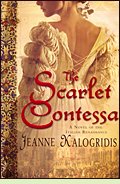|
The Scarlet Contessaby Jeanne KalogridisReviewed by Margaret Donsbach
The historical Caterina was no model of ethereal womanly virtue. She was an illegitimate daughter of the Duke of Milan, murdered on the day after Christmas 1476 when Caterina was thirteen. Noted for her ravishing beauty and her charm as a hostess, she was also politically astute and a decisive military leader. Two of her three husbands were murdered, and she ruthlessly punished their assassins. She successfully defended her estates against an attack by the Venetian army and held out for over a month against a French attack instigated by Rodrigo Borgia, Pope Alexander VI, who coveted her territory. A fictional adoptive sister of Caterina's narrates the novel. Dea foretells the future with triumph (Tarot) cards. The esoteric spiritual investigations of Marsilio Ficino of Florence intrigue her. The plot is contrived to allow Dea to witness the key moments of Caterina's life. Based on a foundation of research, The Scarlet Contessa is nevertheless designed as thrilling light entertainment, not as a biographical novel. Most characters are larger than life, either exceptionally beautiful or remarkably ugly, exceptionally admirable or remarkably villainous. The plot is streamlined by skipping episodes like Caterina's second marriage to Giacomo Feo and her vicious revenge on his assassins and their families. Plenty of violent episodes remain, however, and imagination is lavished on Caterina's reputed sexual promiscuity. Although the novel's theme urges foregoing revenge in favor of altruistic self-sacrifice, Caterina seems most heroic when she takes command of her army, defying her enemies as she pursues power and vengeance. (2010; 455 pages including a brief Afterword discussing Caterina's life after the close of the novel) More about The Scarlet Contessa at Powell's Books or Amazon.com Interview with author Jeanne Kalogridis
Lucrezia Borgia by Maria Bellonci (1953), a sympathetic novel about the daughter of Rodrigo Borgia, Pope Alexander VI. More info The Book of Love by Sarah Bower (2008), about a young Jewish woman who coverts to Christianity and becomes one of Lucrezia Borgia's ladies-in-waiting. More info The Scarlet City by Hella Haasse (1952), about a young man in sixteenth-century Italy who bears the name of Borgia but doesn't know who his parents were. More info
Caterina Sforza: A Renaissance Virago by Ernst Breisach (1967). More info The Borgias and their Enemies, 1431-1519 by Christopher Hibbert (2008). More info The Renaissance Popes by Gerard Noel (2006). More info
Biographical sketch of Caterina Sforza at the Women Who Lead website The Visconti Tarots at Mary K. Greer's Tarot Blog or Amazon.com
Back to Novels of the Renaissance
|
